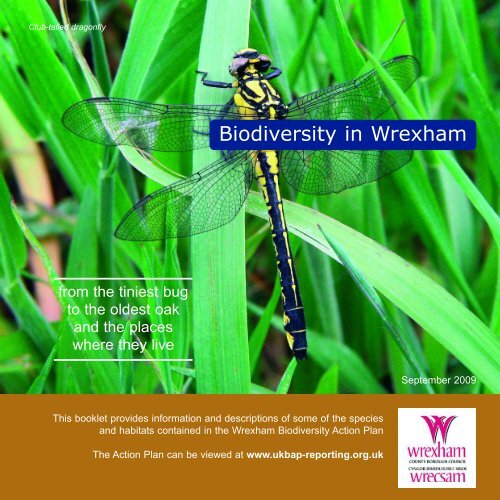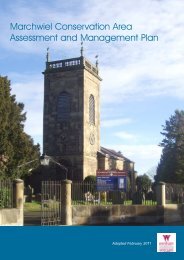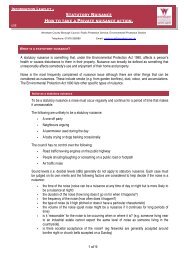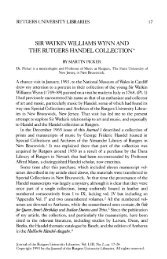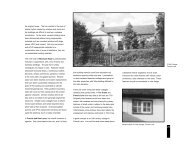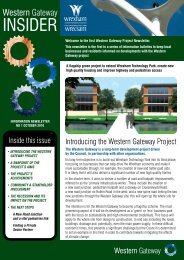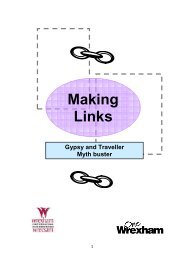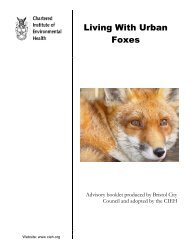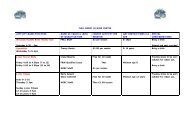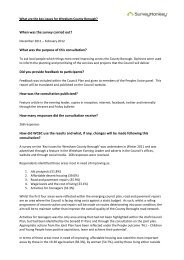Biodiversity in Wrexham - Wrexham County Borough Council
Biodiversity in Wrexham - Wrexham County Borough Council
Biodiversity in Wrexham - Wrexham County Borough Council
You also want an ePaper? Increase the reach of your titles
YUMPU automatically turns print PDFs into web optimized ePapers that Google loves.
Club-tailed dragonfly<br />
<strong>Biodiversity</strong> <strong>in</strong> <strong>Wrexham</strong><br />
from the t<strong>in</strong>iest bug<br />
to the oldest oak<br />
and the places<br />
where they live<br />
September 2009<br />
This booklet provides <strong>in</strong>formation and descriptions of some of the species<br />
and habitats conta<strong>in</strong>ed <strong>in</strong> the <strong>Wrexham</strong> <strong>Biodiversity</strong> Action Plan<br />
The Action Plan can be viewed at www.ukbap-report<strong>in</strong>g.org.uk
Many thanks to the organisations and <strong>in</strong>dividuals who have<br />
supplied photographs for <strong>in</strong>clusion <strong>in</strong> this leaflet <strong>in</strong>clud<strong>in</strong>g<br />
Denbighshire <strong>County</strong> <strong>Council</strong>, English Nature and the<br />
Environment Agency. Copyright is acknowledged with the<br />
photograph. All others are <strong>Wrexham</strong> <strong>County</strong> <strong>Borough</strong> <strong>Council</strong>.<br />
Environment Agency<br />
Young salmon (above) and<br />
Tree sparrow (ma<strong>in</strong>)<br />
This leaflet is available <strong>in</strong> Welsh and <strong>in</strong><br />
alternative formats on request. It is also<br />
available on the <strong>Council</strong>’s website.<br />
www.wrexham.gov.uk/plann<strong>in</strong>g.<br />
Please contact 01978 292518 for<br />
further <strong>in</strong>formation<br />
Ian Spence
<strong>Biodiversity</strong> <strong>in</strong> <strong>Wrexham</strong><br />
Slow worm<br />
Contents<br />
Introduction 2<br />
Wetlands and Fresh Water 7<br />
Uplands 16<br />
Woodlands 20<br />
Lowland Grassland and Heathland 26<br />
Urban and Brownfield 31<br />
Farmland 34<br />
Glossary 40<br />
Contacts 41<br />
Alistair Thomson<br />
Berwyn mounta<strong>in</strong>s<br />
Great raft spider<br />
1
Introduction<br />
What is biodiversity<br />
In simple terms biodiversity means the<br />
variety of life. It encompasses the whole<br />
range of animals, plants and<br />
microorganisms on earth from the t<strong>in</strong>iest<br />
bug to the oldest oak along with the<br />
ecosystems <strong>in</strong> which they live. It <strong>in</strong>cludes<br />
the whole of the natural world from the<br />
commonplace to the critically endangered.<br />
The biodiversity found on Earth today<br />
consists of many millions of dist<strong>in</strong>ct<br />
biological species, which is the product of<br />
nearly 3.5 billion years of evolution.<br />
<strong>Wrexham</strong> <strong>County</strong> <strong>Borough</strong><br />
has an extremely<br />
rich and varied array of<br />
habitats and species<br />
Why conserve it<br />
<strong>Biodiversity</strong> is fundamental to susta<strong>in</strong><strong>in</strong>g<br />
human life on earth. Biological activity<br />
<strong>in</strong>teract<strong>in</strong>g with the environment provides<br />
the essential requirements for life: air, food,<br />
fresh water and shelter. It drives water,<br />
element and nutrient cycles, underp<strong>in</strong>s<br />
function<strong>in</strong>g agricultural systems, <strong>in</strong>fluences<br />
climate and provides protection from<br />
extremes of heat and cold, flood and<br />
drought. It is, at a very basic level, the core<br />
requirement for human survival.<br />
In Wales the biodiversity resource has<br />
value for agriculture, fisheries and timber<br />
production and provides the basis of many<br />
tourism and recreational activities and<br />
provides practical and artistic <strong>in</strong>spiration.<br />
The world's biodiversity is under threat for<br />
several reasons <strong>in</strong>clud<strong>in</strong>g habitat loss due<br />
to changes <strong>in</strong> agriculture, hous<strong>in</strong>g and<br />
<strong>in</strong>dustrial development, pollution of<br />
ecosystems and exploitation of species by<br />
practices such as unsusta<strong>in</strong>able fish<strong>in</strong>g.<br />
The most serious threats for the future,<br />
however, come from climate change and<br />
from <strong>in</strong>vasive species which move <strong>in</strong>to a<br />
habitat where they are not from and<br />
become more successful than resident<br />
species, both relatively recent concerns.<br />
Wild flower meadow at Ty Mawr Country Park<br />
2
R<br />
Key<br />
Brownfield or Previously Developed Land<br />
Floodpla<strong>in</strong> Grasslands<br />
Important Rivers and Streams<br />
Lowland Raised Bog<br />
Uplands<br />
Woodlands<br />
Wood Pasture and Parkland<br />
Urban Areas<br />
Llay<br />
Bwlchgwyn Brymbo Gwersyllt<br />
Summerhill<br />
M<strong>in</strong>era Broughton<br />
Coedpoeth <strong>Wrexham</strong><br />
R i v<br />
Rhosllannerchrugog<br />
Johnstown<br />
Penycae<br />
Ruabon<br />
Acrefair<br />
Trevor<br />
Cefn<br />
Mawr<br />
e<br />
Rhostyllen<br />
r<br />
Burton<br />
Cl<br />
Rossett<br />
Marford<br />
Gresford<br />
y w<br />
e d<br />
o<br />
<strong>Wrexham</strong><br />
Industrial<br />
Estate<br />
Overton<br />
Holt<br />
Marchwiel<br />
Cross Lanes<br />
Worthenbury<br />
R i v e<br />
g<br />
r D<br />
e e<br />
Bangor-is-y-Coed<br />
Tallarn Green<br />
Dee Valley at Ty Mawr<br />
Froncysyllte<br />
Penley<br />
Hanmer<br />
Bron<strong>in</strong>gton<br />
i v<br />
e<br />
r<br />
C<br />
Glyn Ceiriog<br />
E<br />
I R<br />
I O G<br />
V A L L<br />
E<br />
Y<br />
Pontfadog<br />
Chirk<br />
Bettisfield<br />
C<br />
e<br />
i<br />
r<br />
i<br />
o g<br />
Llanarmon<br />
Dyffryn<br />
Ceiriog<br />
<strong>Wrexham</strong> <strong>County</strong> <strong>Borough</strong>: Distribution of Habitats<br />
Ruabon Mounta<strong>in</strong><br />
<strong>Biodiversity</strong> <strong>in</strong> <strong>Wrexham</strong><br />
<strong>Wrexham</strong> <strong>County</strong> <strong>Borough</strong> possesses an<br />
extremely rich and varied array of habitats<br />
and species. From east to west there is<br />
<strong>in</strong>credible diversity result<strong>in</strong>g from<br />
differences <strong>in</strong> soils, topography, land use<br />
and legacies of the past. To the west, the<br />
open moorland of the Ruabon and<br />
Esclusham Mounta<strong>in</strong>s are a valuable<br />
habitat for several important bird<br />
populations <strong>in</strong>clud<strong>in</strong>g the most important<br />
site for black grouse <strong>in</strong> Wales. The River<br />
Ceiriog Valley, and surround<strong>in</strong>g Berwyn<br />
Mounta<strong>in</strong>s, are a patchwork of small farms,<br />
woodlands, open moorland and scrub.<br />
In the eastern lowland areas of the<br />
borough <strong>in</strong>clud<strong>in</strong>g the River Dee and its<br />
floodpla<strong>in</strong>, extensive areas of floodpla<strong>in</strong><br />
meadow support an array of breed<strong>in</strong>g<br />
birds, <strong>in</strong>sects and small mammals. The<br />
extremely dense occurrence of ponds <strong>in</strong><br />
the lowlands is of European importance<br />
and essential for the protection of the great<br />
crested newt population. Fenns, Whixall<br />
and Bettisfield Moss National Nature<br />
Reserve, once formed part of a huge<br />
lowland raised bog site which developed<br />
after the last glaciation. The peat body<br />
supports dozens of locally and nationally<br />
rare species and is of European<br />
importance.<br />
3
Protect<strong>in</strong>g our Sites<br />
Throughout <strong>Wrexham</strong> <strong>County</strong> <strong>Borough</strong><br />
there are numerous sites designated and<br />
protected because of their importance to<br />
wildlife. In total there are 5 sites protected<br />
under European Law known as Special<br />
Areas of Conservation (SACs) and Special<br />
Protection Areas (SPAs), 18 sites protected<br />
under British law called Sites of Special<br />
Scientific Interests (SSSIs), 4 Internationally<br />
protected wetlands (Ramsar sites) and a<br />
Local Nature Reserve at Alyn Waters<br />
Country Park. There are also 161 Local<br />
Wildlife Sites that receive no statutory<br />
protection but are protected under plann<strong>in</strong>g<br />
policy.<br />
Pa<strong>in</strong>ted lady butterfly<br />
<strong>Wrexham</strong> has 4 <strong>in</strong>ternationally protected<br />
wetlands and 5 sites protected<br />
under European law known<br />
as Special Areas of Conservation<br />
SSSIs In <strong>Wrexham</strong> <strong>County</strong> <strong>Borough</strong><br />
Afon Dyfrdwy / River Dee * Hanmer Mere # Pandy Quarry<br />
Berwyn * Llay Bog Ruabon/ Llantysilio Mounta<strong>in</strong>s and M<strong>in</strong>era *<br />
Chawarel S<strong>in</strong>gret Llyn Bedydd # Shell Brook Pastures<br />
Cloy Brook Pastures Marford Quarry Sontley Marsh<br />
Fenns, Whixall, Bettisfield, Wem and Cadney Mosses *#<br />
Nant Y Belan and Prynela Wood<br />
Stryt Las A'r Hafod/ Johnstown Newt Site *<br />
Gatewen Marsh Old Pulford Brook Meadows Vicarage Moss #<br />
*SAC #Ramsar<br />
4
<strong>Wrexham</strong> <strong>Biodiversity</strong><br />
Action Plan<br />
<strong>Wrexham</strong>'s biodiversity is part of a global<br />
network! The UK's way of safeguard<strong>in</strong>g<br />
biodiversity is through <strong>Biodiversity</strong> Action<br />
Plans (BAPs). A <strong>Biodiversity</strong> Action Plan<br />
(BAP) is an <strong>in</strong>ternationally recognised<br />
program address<strong>in</strong>g the decl<strong>in</strong>e of<br />
threatened species and habitats that is<br />
designed to protect and restore biological<br />
systems. The plans derived from the<br />
Convention of Biological Diversity (CBD)<br />
adopted <strong>in</strong> Rio de Janeiro <strong>in</strong> June 1992.<br />
A Local <strong>Biodiversity</strong> Action Plan (LBAP)<br />
focus' resources to conserve and enhance<br />
biodiversity by means of local partnerships,<br />
tak<strong>in</strong>g account of both national and local<br />
priorities. An LBAP ensures those national<br />
targets for species and habitats are<br />
translated <strong>in</strong>to local action. They identify<br />
targets for species and habitats appropriate<br />
to local areas, reflect<strong>in</strong>g the values of<br />
people locally and develop effective local<br />
partnerships.<br />
Partnership<br />
The successful implementation of the<br />
<strong>Biodiversity</strong> Action Plan objectives and<br />
targets requires <strong>in</strong>volvement from a variety<br />
of partners <strong>in</strong>clud<strong>in</strong>g landowners, local<br />
authorities, statutory conservation agencies<br />
and voluntary bodies. The aim of the<br />
partnership approach is to share the<br />
workload and to <strong>in</strong>volve a wide range of<br />
resources and skills. It also ensures that<br />
there is a shared commitment to, and<br />
ownership of, the plan process.<br />
Established <strong>in</strong> February 2001, the<br />
<strong>Wrexham</strong> <strong>Biodiversity</strong> Group <strong>in</strong>cludes<br />
members from over 20 organisations and<br />
<strong>in</strong>dividuals, such as local recorders. Group<br />
members assist with the preparation of<br />
plans and achiev<strong>in</strong>g targets.<br />
Betty Lee<br />
3 Rivers Project volunteers construct<strong>in</strong>g an otter holt<br />
5
Identify<strong>in</strong>g Local Priority<br />
Habitats and Species<br />
The Natural Environment & Rural<br />
Communities Act 2006 states that "The<br />
National Assembly for Wales must publish a<br />
list of the liv<strong>in</strong>g organisms and types of<br />
habitat which <strong>in</strong> the Assembly's op<strong>in</strong>ion are<br />
of pr<strong>in</strong>cipal importance for the purpose of<br />
conserv<strong>in</strong>g biodiversity." This list is known<br />
as the Section 42 List, and forms the basis<br />
for which habitats and species are <strong>in</strong>cluded<br />
<strong>in</strong> the <strong>Wrexham</strong> LBAP. All Section 42<br />
habitats found <strong>in</strong> <strong>Wrexham</strong> <strong>County</strong> <strong>Borough</strong><br />
have targets on the BARS website, as do<br />
many of the species occurr<strong>in</strong>g <strong>in</strong> the county.<br />
In addition to those species considered of<br />
pr<strong>in</strong>ciple importance to Wales, additional<br />
species such as barn owl are <strong>in</strong>cluded <strong>in</strong><br />
the <strong>Wrexham</strong> LBAP, they are classed as<br />
local priority species. These local priority<br />
species are those which are thought to be<br />
<strong>in</strong> decl<strong>in</strong>e, have fragile populations locally<br />
(though not nationally), or have a high<br />
profile which can be used for conservation<br />
of other species. A full list of species which<br />
are <strong>in</strong>cluded <strong>in</strong> the <strong>Wrexham</strong> LBAP can be<br />
found on the BARS web site: www.ukbapreport<strong>in</strong>g.org.uk.<br />
Records of habitats and<br />
species are brought together by Cofnod, the<br />
North Wales Record Centre. Hav<strong>in</strong>g all<br />
biological records passed to a central po<strong>in</strong>t<br />
makes identify<strong>in</strong>g species that are decl<strong>in</strong><strong>in</strong>g<br />
or becom<strong>in</strong>g rare much easier.<br />
BARS<br />
The <strong>Biodiversity</strong> Action Report<strong>in</strong>g System,<br />
known as BARS, is the web-based<br />
<strong>in</strong>formation system that supports the<br />
plann<strong>in</strong>g, monitor<strong>in</strong>g and report<strong>in</strong>g<br />
requirements of UK, national, local and<br />
company <strong>Biodiversity</strong> Action Plans (BAPs).<br />
It also allows users to learn about the<br />
progress be<strong>in</strong>g made towards local and<br />
national targets. Detailed targets and<br />
objectives for LBAP habitats and species <strong>in</strong><br />
<strong>Wrexham</strong> <strong>County</strong> <strong>Borough</strong> can be seen on<br />
the BARS website.<br />
Banded Demoiselle<br />
6
Wetlands and Fresh Water<br />
Wetlands are a vitally important habitat,<br />
support<strong>in</strong>g a huge variety of wildlife and<br />
some of our most threatened and rare<br />
species. <strong>Wrexham</strong> <strong>County</strong> <strong>Borough</strong> is<br />
fortunate to boast some exceptional<br />
wetland habitats <strong>in</strong>clud<strong>in</strong>g a nationally<br />
important pondscape, some of the<br />
<strong>in</strong>ternationally important Meres and<br />
Mosses Sites and a number of valuable<br />
river corridors. Wetlands are habitats<br />
which are vulnerable to damage and<br />
destruction, particularly by pollution and<br />
hydrological changes.<br />
River Dee at Holt<br />
Stream <strong>in</strong> Bettisfield<br />
7
Rivers and Streams<br />
Rivers and streams are flow<strong>in</strong>g<br />
watercourses and <strong>in</strong> their natural state are<br />
dynamic systems, cont<strong>in</strong>ually modify<strong>in</strong>g<br />
their form. The habitat consists not only the<br />
watercourse itself - the "wetted channel" but<br />
also the bank and associated land known<br />
as the riparian zone. The habitat provides a<br />
wide range of ecological niches support<strong>in</strong>g<br />
flora and fauna, many of which are priority<br />
species for Wales. Many species that occur<br />
<strong>in</strong> watercourses are entirely dependent on<br />
the habitat for part or all of their life cycle<br />
and are unable to adapt to other<br />
environments. Watercourses form important<br />
wildlife corridors, allow<strong>in</strong>g movement of<br />
species between fragmented areas and<br />
connect different riverbank habitats.<br />
There are over 180 km of pr<strong>in</strong>cipal<br />
rivers <strong>in</strong> the <strong>Borough</strong> <strong>in</strong>clud<strong>in</strong>g the Dee,<br />
Ceiriog, Alyn and Clywedog and a<br />
number of important streams<br />
8<br />
River Dee at Cefn Mawr
In towns, urban rivers and streams and the<br />
surround<strong>in</strong>g riparian zone can be valuable<br />
habitats for many species, and are a<br />
recreational and educational resource for<br />
the community. However, with<strong>in</strong> an urban<br />
area the riparian zone is frequently replaced<br />
with either built environment or landscaped<br />
open space "amenity" areas, both of which<br />
may be of limited biodiversity value.<br />
River Dee at Ty Mawr<br />
River Gwenfro flow<strong>in</strong>g through Caia Park<br />
River Alyn<br />
The county borough has a rich and<br />
<strong>in</strong>tricate network of waterways rang<strong>in</strong>g<br />
from upland streams to meander<strong>in</strong>g slow<br />
lowland rivers. There are over 180 km of<br />
pr<strong>in</strong>cipal rivers <strong>in</strong>clud<strong>in</strong>g the Dee, Ceiriog,<br />
Alyn and Clywedog and a number of<br />
important streams shown on the map. The<br />
River Dee and four of its tributaries (the<br />
Ceiriog, Tryweryn, Mynach and Meloch)<br />
are designated as a SSSI and a SAC.<br />
M O U N TA I N<br />
R U A B O N<br />
River Clywedog<br />
River Dee<br />
River Dee<br />
B E R W Y N M O U N TA<br />
I N S<br />
River Ceiriog<br />
Llangollen Canal<br />
Important waterways <strong>in</strong> the borough<br />
Upland stream<br />
9
Lowland Raised Bog<br />
Lowland raised bogs, or Mosses, are a rare<br />
but highly dist<strong>in</strong>ctive part of the peatlands of<br />
Wales. The last glaciation left many<br />
depressions <strong>in</strong> the landscape, which have<br />
<strong>in</strong>-filled with peat over the past ten<br />
thousand years, often progress<strong>in</strong>g from<br />
open water through swamp, fen and carr to<br />
acidic raised mire. As the hollows fill <strong>in</strong>, the<br />
gradual build-up of peat raises and isolates<br />
the surface of the mire from the <strong>in</strong>fluence of<br />
surface run-off and groundwater, and ra<strong>in</strong>fed<br />
(ombrogenous) peat beg<strong>in</strong>s to form.<br />
Sphagnum bogmosses acidify the ra<strong>in</strong>water,<br />
pickl<strong>in</strong>g bog plant rema<strong>in</strong>s, build<strong>in</strong>g up a<br />
dome of acidic peat sometimes up to 10<br />
metres thick - a multimillennial record of<br />
past landscape and climate change. The<br />
classically domed raised bog profile is<br />
rarely visible, as bogs have collapsed when<br />
they have been dra<strong>in</strong>ed. Small sites sitt<strong>in</strong>g<br />
<strong>in</strong> dist<strong>in</strong>ct depressions are called bas<strong>in</strong><br />
mires.<br />
Fenns Moss<br />
Fenns, Whixall, Bettisfield, Wem and<br />
Cadney Mosses which straddle the<br />
English/Welsh border are of <strong>in</strong>ternational<br />
importance for their characteristic bog<br />
vegetation and associated wildlife. They are<br />
one of the most southerly raised bogs <strong>in</strong><br />
Brita<strong>in</strong> and the third largest. In 1990 the<br />
area was saved for wildlife conservation<br />
after a dramatic <strong>in</strong>crease <strong>in</strong> the rate of<br />
commercial peat extraction threatened its<br />
destruction. As a result of the management<br />
as a National Nature Reserve bogmosses<br />
are now recolonis<strong>in</strong>g, dragonflies have<br />
spread and waders such as curlews are<br />
prosper<strong>in</strong>g.<br />
10
Bettisfield Moss<br />
Other protected sites <strong>in</strong>clude Vicarage<br />
Moss and Llay Bog SSSI which are bas<strong>in</strong><br />
mires developed <strong>in</strong> kettle holes near<br />
<strong>Wrexham</strong>. Both have a small central area<br />
of raised mire plants. There are also<br />
several small degraded sites which are of<br />
local importance, these <strong>in</strong>clude the Conery<br />
(orig<strong>in</strong>ally part of Fenn's Moss), Arowry<br />
Moss and the Cranberry Mosses both ly<strong>in</strong>g<br />
<strong>in</strong> glacial depressions <strong>in</strong> south west of the<br />
borough. They reta<strong>in</strong> a few bog species but<br />
are wooded over, as is Borras Bog near<br />
<strong>Wrexham</strong>.<br />
<strong>Borough</strong> Boundary<br />
Special Areas of Conservation<br />
Sites of Special Scientific Interest<br />
Local Nature Reserve<br />
Wildlife Sites<br />
M O U N TA I N<br />
R U A B O N<br />
R<br />
I N<br />
I V E R<br />
F L O O D P L A<br />
D E E<br />
Fenns Moss<br />
T H E M A E L O R<br />
D E E VA L L E Y<br />
B E R W Y N M O U N TA<br />
I N S<br />
C E<br />
I R<br />
I O G<br />
V A L L E Y<br />
Protected sites with<strong>in</strong> the county<br />
Hand cut peat<br />
11
Ponds<br />
<strong>Wrexham</strong> <strong>County</strong> <strong>Borough</strong> has one of the<br />
most important pondscapes <strong>in</strong> the UK. They<br />
are a very important habitat and are<br />
essential to many species that require water<br />
to complete their life-cycle such as<br />
amphibians and dragonflies. Species like<br />
water vole and otter rely simply on ponds<br />
for breed<strong>in</strong>g or feed<strong>in</strong>g. Ponds support a<br />
considerable number of key species, many<br />
of which are protected by European or<br />
statutory legislation. Those with statutory<br />
protection <strong>in</strong>clude at least 65 priority<br />
species. There are also a m<strong>in</strong>imum of 28<br />
animal and plant species given some<br />
protection under the Wildlife and<br />
Countryside Act. Species protected under<br />
European legislation <strong>in</strong>clude great crested<br />
newt, white-clawed crayfish, otter (<strong>in</strong> larger<br />
ponds) and float<strong>in</strong>g water planta<strong>in</strong>.<br />
Past and recent studies us<strong>in</strong>g maps and<br />
aerial photographs have recorded<br />
approximately 3000 ponds <strong>in</strong> the county<br />
borough. They are predom<strong>in</strong>antly former<br />
clay or marl pits, which provided fertiliser or<br />
clay for brick mak<strong>in</strong>g <strong>in</strong> the Middle Ages.<br />
The highest densities occur <strong>in</strong> the parishes<br />
of Hanmer, Maelor and Overton, where the<br />
density exceeds 15 ponds per km 2 over the<br />
whole area.<br />
Water dock found <strong>in</strong> a large pond<br />
12
Common frog<br />
Ponds are by def<strong>in</strong>ition small bodies of<br />
water (under 2ha), a fact that makes them<br />
<strong>in</strong>herently vulnerable to damage. The<br />
factors which can degrade ponds are widerang<strong>in</strong>g<br />
and <strong>in</strong>clude: pollution caused by<br />
agricultural chemicals, urban run-off and<br />
acid ra<strong>in</strong>; direct loss caused by <strong>in</strong>-fill<strong>in</strong>g;<br />
vegetation succession; <strong>in</strong>troduction or<br />
colonisation of non-native species and<br />
<strong>in</strong>appropriate pond management.<br />
Field pond<br />
Large emerald damselfly<br />
Pond density<br />
4-14 ponds per sq.km<br />
15+ ponds per sq.km<br />
Andy Harmer<br />
Lesser silver div<strong>in</strong>g beetle<br />
13
Wetland Species<br />
Water Vole<br />
The water vole is the largest and most<br />
famous of the British voles, it was<br />
immortalised as 'Ratty' <strong>in</strong> Kenneth<br />
Grahame's W<strong>in</strong>d <strong>in</strong> the Willows. Water<br />
voles have a short hair-covered tail, a blunt,<br />
rounded nose, and a small chubby face<br />
with small ears. They have a rich chestnutbrown<br />
coat, which traps air that provides<br />
thermal <strong>in</strong>sulation when swimm<strong>in</strong>g. Once a<br />
very familiar mammal of the British<br />
countryside, the population has undergone<br />
one of the fastest and most serious recent<br />
decl<strong>in</strong>es of any British mammal. In<br />
<strong>Wrexham</strong> <strong>County</strong> <strong>Borough</strong> several<br />
populations hang on, the most robust be<strong>in</strong>g<br />
found <strong>in</strong> the Bettisfield area, on the edge of<br />
the Mosses complex.<br />
Rob Strachan<br />
Water vole<br />
Fenns Moss<br />
14
Great Crested Newt<br />
The largest of the three species of newt that<br />
are native to Brita<strong>in</strong>. They require suitable<br />
terrestrial habitat (woodland, scrub, rough<br />
grassland) adjacent to the breed<strong>in</strong>g ponds,<br />
and their long-term survival may depend on<br />
the existence of a network of ponds (with<strong>in</strong><br />
500m of each other) l<strong>in</strong>ked by suitable<br />
terrestrial habitat. Their future <strong>in</strong> the county<br />
borough is closely l<strong>in</strong>ked to the<br />
disappearance of ponds through <strong>in</strong>fill<strong>in</strong>g and<br />
development pressure. Stryt Las and Hafod<br />
SSSI is designated for its population of<br />
newts.<br />
Great crested newt<br />
John Rob<strong>in</strong>son<br />
Great crested newt<br />
Andy Harmer<br />
Salmon return<strong>in</strong>g to their breed<strong>in</strong>g ground<br />
Environment Agency<br />
Salmon<br />
Atlantic salmon return to breed <strong>in</strong> various<br />
locations <strong>in</strong> rivers throughout <strong>Wrexham</strong><br />
<strong>County</strong> <strong>Borough</strong>. After return<strong>in</strong>g to fresh<br />
water the salmon will cease eat<strong>in</strong>g<br />
altogether prior to spawn<strong>in</strong>g. Although it is<br />
largely unknown how they return to the<br />
same spot, it has been suggested that odour<br />
(the exact chemical signature of that stream)<br />
plays an important role <strong>in</strong> this process. Once<br />
hatched the juveniles grow through several<br />
dist<strong>in</strong>ct stages, before prepar<strong>in</strong>g to leave for<br />
the sea. Once <strong>in</strong> salt water they undergo<br />
their greatest feed<strong>in</strong>g and grow up to 39kg<br />
or 150cm before return<strong>in</strong>g upstream to<br />
spawn <strong>in</strong> native freshwater streams where<br />
their eggs hatched.<br />
15
Uplands<br />
There are two upland areas <strong>in</strong> <strong>Wrexham</strong><br />
<strong>County</strong> <strong>Borough</strong>, they are both located on<br />
the Western edge. The Berwyn Mounta<strong>in</strong>s<br />
which are over 450 m above sea level ris<strong>in</strong>g<br />
to 784 m at its highest po<strong>in</strong>t, and the<br />
Ruabon and Esclusham Mounta<strong>in</strong> between<br />
350 and 450m. Both of these areas<br />
comprise <strong>in</strong>tricate mosaics of habitats<br />
primarily blanket bog and upland heathland<br />
<strong>in</strong>terspersed with other habitats such as<br />
bracken, flushes and acid grassland. Both<br />
Ruabon Mounta<strong>in</strong> and the Berwyn<br />
Mounta<strong>in</strong>s are designated as SSSIs and<br />
SACs, both support<strong>in</strong>g the habitats of<br />
upland heathland and blanket bog. There<br />
are also small fragmented areas of<br />
heathland and modified bogs on hill slopes<br />
below these two moorland areas. These<br />
remnant moorland habitats are designated<br />
as Wildlife Sites and <strong>in</strong>clude sites such as<br />
Bryn Llyn-Gloyw and Llechrydau <strong>in</strong> the<br />
Ceiriog Valley. The uplands support a vast<br />
array of rare and threatened species,<br />
particularly birds such as hen harrier, merl<strong>in</strong><br />
and black grouse.<br />
Hen harrier<br />
The uplands support a<br />
vast array of rare and<br />
threatened species<br />
Ian Spence<br />
Views towards the Berwyn Mounta<strong>in</strong>s<br />
from Ruabon Mounta<strong>in</strong><br />
16
Blanket Bog<br />
Blanket bog occurs on deeper peat and is<br />
usually dom<strong>in</strong>ated by heather and hare'stail<br />
cotton-grass and characteristic bog<br />
mosses (Sphagna). It is exclusively ra<strong>in</strong>fed,<br />
form<strong>in</strong>g peat <strong>in</strong> cool oceanic climates with<br />
low temperatures and high and regular<br />
ra<strong>in</strong>fall. Peat depth is very variable, with an<br />
average of 0.5 - 3m be<strong>in</strong>g fairly typical but<br />
depths <strong>in</strong> excess of 5m are not unusual.<br />
Blanket bog peat accumulates <strong>in</strong> response<br />
to the very slow rate at which plant material<br />
decomposes under cold, waterlogged<br />
conditions. It can cloak whole landscapes,<br />
even develop<strong>in</strong>g on slopes of up to 30°.<br />
Some bog systems have been<br />
accumulat<strong>in</strong>g peat for over 10,000 years,<br />
form<strong>in</strong>g an important archeological record.<br />
Esclusham Mounta<strong>in</strong><br />
Heather<br />
Heathland<br />
Ruabon Mounta<strong>in</strong><br />
Upland Heathland<br />
Upland heathland usually can be found at<br />
the upper edge of enclosed agricultural<br />
land (generally at around 250-400m). A<br />
range of dwarf shrubs such as heather,<br />
bilberry, crowberry, bell heather and<br />
western gorse typically dom<strong>in</strong>ate. It is<br />
characterised by the presence of dwarf<br />
shrubs over a quarter of the area. Wet<br />
heath is most commonly found on the<br />
wetter north and west fac<strong>in</strong>g slopes and is<br />
dom<strong>in</strong>ated by mixtures of cross-leaved<br />
heath, deer grass, heather and purple<br />
moor-grass, over an understorey of<br />
mosses often <strong>in</strong>clud<strong>in</strong>g carpets of bog<br />
mosses (Sphagna). High quality heaths are<br />
generally structurally diverse, conta<strong>in</strong><strong>in</strong>g<br />
stands of vegetation with heather at<br />
different stages of growth.<br />
17
Upland Species<br />
Black Grouse<br />
Black grouse are gamebirds that ma<strong>in</strong>ly<br />
live on moorland marg<strong>in</strong>s and forest<br />
edge. The black grouse is one of only<br />
three British bird species that exhibit<br />
lekk<strong>in</strong>g behaviour. This <strong>in</strong>terest<strong>in</strong>g<br />
phenomenon <strong>in</strong>volves male grouse or<br />
cocks display<strong>in</strong>g on a traditional lekk<strong>in</strong>g<br />
site. The cocks compete with each other<br />
for best display sites with<strong>in</strong> the lek, with<br />
dom<strong>in</strong>ant <strong>in</strong>dividuals occupy<strong>in</strong>g central<br />
sites. The bubbl<strong>in</strong>g calls and the postur<strong>in</strong>g<br />
of the cocks attract hens, who choose their<br />
mate. The black grouse is a potent symbol<br />
of the way <strong>in</strong> which land-use changes <strong>in</strong> the<br />
uplands have affected biodiversity.<br />
Esclusham Mounta<strong>in</strong><br />
Black grouse<br />
CCW<br />
Agricultural practices dur<strong>in</strong>g the last forty<br />
years have substantially changed the<br />
landscape mosaic which black grouse<br />
require. Encouraged by production<br />
subsidies, rough-graz<strong>in</strong>g land has been<br />
dra<strong>in</strong>ed, ploughed and re-seeded,<br />
encourag<strong>in</strong>g the growth of rye grass at the<br />
expense of heather and other dwarf shrubs.<br />
These fields are regularly fertilised,<br />
reduc<strong>in</strong>g the variety of grass species.<br />
18
Black grouse<br />
CCW<br />
Heavy graz<strong>in</strong>g by sheep, deer and rabbits<br />
reduces the amount of tall vegetation that<br />
the grouse require for shelter, perhaps<br />
mak<strong>in</strong>g them more vulnerable to predation.<br />
Dra<strong>in</strong>age removes wet flushes conta<strong>in</strong><strong>in</strong>g<br />
<strong>in</strong>vertebrates which are vital to black<br />
grouse chicks <strong>in</strong> their first few weeks of<br />
life. As commercial forestry plantations<br />
have matured, the dwarf shrubs (such as<br />
heather, which adult grouse require for<br />
food and shelter) are lost, s<strong>in</strong>ce they<br />
cannot tolerate the deep shade under the<br />
trees. In North Wales, black grouse has<br />
been fight<strong>in</strong>g its way back from the br<strong>in</strong>k of<br />
ext<strong>in</strong>ction for around fifteen years. RSPB<br />
Cymru, Forest Enterprise Wales, the<br />
Countryside <strong>Council</strong> for Wales and other<br />
landowners have been work<strong>in</strong>g closely on<br />
a Black Grouse Recovery Project s<strong>in</strong>ce<br />
1998.<br />
Adder<br />
The adder is Brita<strong>in</strong>'s only venomous snake<br />
and is, as a result, a much-maligned<br />
species with a wealth of folklore<br />
surround<strong>in</strong>g it. Despite the public perception<br />
of this snake, it is a shy, timid and nonaggressive<br />
species. Adders require<br />
adequate bask<strong>in</strong>g and hibernation sites,<br />
and are often found <strong>in</strong> areas of sparse<br />
vegetation where they may utilise the<br />
burrows of small rodents. It hibernates<br />
communally, deeper <strong>in</strong> the<br />
ground than other British<br />
reptiles, and emerges earlier<br />
<strong>in</strong> the spr<strong>in</strong>g. Bask<strong>in</strong>g areas<br />
are near to hibernation sites<br />
and must be free of shad<strong>in</strong>g vegetation.<br />
Female adders reproduce once every two<br />
years and are 'viviparous'; they give birth to<br />
live young, which are <strong>in</strong>itially encased <strong>in</strong> a<br />
membrane. Although adders are poisonous,<br />
they are not aggressive and rarely bite<br />
humans or domestic animals, preferr<strong>in</strong>g to<br />
retreat <strong>in</strong>to thick vegetation <strong>in</strong>stead. Most<br />
adder bite <strong>in</strong>cidents result when they are<br />
picked up or trodden upon, and <strong>in</strong> most<br />
cases they are not serious.<br />
Adder<br />
Will Middlemass (left) William Hankers (above)<br />
19
Woodlands<br />
For thousands of years after the end of the<br />
last ice age, the British Isles were covered<br />
with natural woodlands. The history of these<br />
enormous woodlands beg<strong>in</strong>s when the last<br />
glaciation ended. Woodland is the 'climax'<br />
vegetation of the British Isles and if left<br />
undisturbed by man would cover all but the<br />
small areas of moorland and grassland on<br />
high mounta<strong>in</strong>s. Our early ancestors began<br />
to clear the woodlands to create farmland<br />
and as a result the woodland component<br />
steadily decl<strong>in</strong>ed so that by the medieval<br />
period, woodland cover had reduced<br />
dramatically.<br />
The ma<strong>in</strong> woodland types of biodiversity<br />
significance are upland oak, mixed upland<br />
ash, wet and scrub woodlands as well as<br />
veteran trees and wood-pasture.<br />
Today, only 2.6 % of the orig<strong>in</strong>al<br />
ancient woodland support<strong>in</strong>g our native<br />
broadleaved tree species rema<strong>in</strong>s <strong>in</strong><br />
<strong>Wrexham</strong> <strong>County</strong> <strong>Borough</strong><br />
20
Wet Woodland<br />
Wet deciduous woodland is often found on<br />
floodpla<strong>in</strong>s and as small patches with<strong>in</strong><br />
larger wooded areas when damp ground is<br />
colonised by species such as willow, birch<br />
and alder. Woodland on wet boggy ground,<br />
is referred to as carr, it can occur on a wide<br />
range of substrates, from acid to base-rich<br />
and peaty to m<strong>in</strong>eral soils. Wet woodland is<br />
an extremely rich <strong>in</strong>vertebrate habitat,<br />
support<strong>in</strong>g a very large number of species,<br />
many of which are now rare <strong>in</strong> Brita<strong>in</strong>.<br />
There have been considerable losses of<br />
wet woodland habitats <strong>in</strong> Brita<strong>in</strong> <strong>in</strong> the last<br />
century, due to clearance, conversion to<br />
other land-uses or the lower<strong>in</strong>g of watertables<br />
through dra<strong>in</strong>age or abstraction.<br />
Wet woodland<br />
<strong>in</strong> Sontley<br />
Dead wood provides specialised habitats<br />
The number of <strong>in</strong>vertebrates associated<br />
with alder, birch and willows, is very large<br />
and some species are now conf<strong>in</strong>ed to just<br />
a few sites. Even quite small wet areas<br />
may support craneflies such as the near<br />
endemic Lipsothrix nervosa which is found<br />
<strong>in</strong> the Erddig area. Dead wood with<strong>in</strong> these<br />
woodland sites can be frequent, provid<strong>in</strong>g<br />
a specialised habitat not found <strong>in</strong> dry<br />
woodland types.<br />
Alistair Thomson<br />
Wet woodland <strong>in</strong> Sontley<br />
Cranefly<br />
21
Pontfadog oak<br />
You can travel throughout Europe<br />
and hardly catch a glimpse of any<br />
tree more than 200 years old<br />
Wood pasture,<br />
Parklands and Veteran Trees<br />
Lowland wood-pastures and parkland are<br />
the products of historic land management<br />
systems, and represent a vegetation<br />
structure rather than be<strong>in</strong>g a particular plant<br />
community. Typically this structure consists<br />
of large, mature open-grown or high forest<br />
trees (often pollards) at various densities, <strong>in</strong><br />
a matrix of grazed grassland, heathland<br />
and/or woodland floras. Ancient trees are<br />
part of our history and culture, they have<br />
been honoured s<strong>in</strong>ce time immemorial. You<br />
can travel throughout Europe and hardly<br />
catch a glimpse of any tree more than 200<br />
years old. In Brita<strong>in</strong> we are more fortunate.<br />
Veteran trees can still be found here, <strong>in</strong><br />
ancient deer parks, pasture woodland and<br />
old wooded commons, on village greens,<br />
parish boundaries and mark<strong>in</strong>g the routes<br />
of ancient trackways.<br />
Others can be found <strong>in</strong> hedgerows,<br />
remnant hedgerows and <strong>in</strong> churchyards,<br />
particularly yews. In the <strong>County</strong> <strong>Borough</strong><br />
there is an estimated 4330 hectares of<br />
parkland habitat and it is ma<strong>in</strong>ly associated<br />
with estate lands. They <strong>in</strong>clude Chirk Castle<br />
and Erddig (both owned and managed by<br />
the National Trust), Brynk<strong>in</strong>allt, Pen-y-lan,<br />
Gred<strong>in</strong>gton, Bettisfield Park, Iscoyd Park,<br />
Rosehill, Overton Park and Cefn Park.<br />
There are also some f<strong>in</strong>e examples of<br />
veteran trees <strong>in</strong>clud<strong>in</strong>g the yews at<br />
Gresford and Overton churches and the<br />
Pontfadog Oak which is thought to be 1200<br />
years old.<br />
22
Lowland Mixed Deciduous Woodland<br />
Most of the woodlands <strong>in</strong> <strong>Wrexham</strong> <strong>County</strong><br />
<strong>Borough</strong> conta<strong>in</strong> one or more of the<br />
follow<strong>in</strong>g species: oak, ash, elm, sycamore,<br />
birch, cherry, hazel, alder, rowan, hawthorn<br />
and holly. Their ability to grow alone or <strong>in</strong><br />
mixtures, usually <strong>in</strong> small areas on steep<br />
sided valleys or neglected agricultural land,<br />
constitutes the woodlands we associate<br />
with the countryside. Left to nature, treeless<br />
areas are first populated by light seed<strong>in</strong>g<br />
pioneer species such as birch and goat<br />
willow which are relatively short-lived and<br />
are soon overtaken by other light<br />
demand<strong>in</strong>g climax species such as oak, ash<br />
and elm.<br />
Below the canopy, shade-bear<strong>in</strong>g species<br />
such as hazel, holly and hawthorn await<br />
their niche when a mature neighbour<strong>in</strong>g<br />
tree dies. The ecological significance of<br />
ancient mixed deciduous woodland <strong>in</strong> the<br />
county borough is reflected <strong>in</strong> the<br />
abundance and diversity of species of both<br />
flora and fauna. The most notable botanical<br />
component of ancient woodlands is the<br />
diversity of flowers, ferns, mosses and<br />
liverworts that <strong>in</strong> turn support a rich diversity<br />
of birds, animals and <strong>in</strong>sects.<br />
Fungi<br />
Wild garlic<br />
Bluebells found <strong>in</strong> Erddig’s woodland<br />
23
Black Poplar<br />
The black poplar is Brita<strong>in</strong>'s rarest native<br />
timber tree. A thousand years ago it thrived<br />
across the lowland floodpla<strong>in</strong>s of<br />
the British countryside. It was<br />
once such a common sight that it<br />
features <strong>in</strong> many classic pa<strong>in</strong>t<strong>in</strong>gs<br />
of the British countryside,<br />
<strong>in</strong>clud<strong>in</strong>g John Constable's The<br />
Hay Wa<strong>in</strong>. The trees are typically<br />
characterised by their large<br />
unga<strong>in</strong>ly appearance with<br />
massive arch<strong>in</strong>g down-turned<br />
branches and burred trunks with<br />
rough dark bark. In the spr<strong>in</strong>g the<br />
male trees have dist<strong>in</strong>ctive red<br />
catk<strong>in</strong>s. Female trees have green<br />
Catk<strong>in</strong><br />
catk<strong>in</strong>s followed by fluffy white<br />
seeds. For the seeds to germ<strong>in</strong>ate they<br />
need to lie undisturbed on bare, wet mud<br />
from June to October. Trees can also be<br />
propagated from cutt<strong>in</strong>gs. Black poplars<br />
were commonly planted near farms and<br />
develop<strong>in</strong>g villages as they were<br />
considered so useful for build<strong>in</strong>g and<br />
scaffold<strong>in</strong>g. The shaped lower branches<br />
were especially prized for cruck frames and<br />
its toughness made it a favourite of wagon<br />
makers, bowl turners and fletchers. Black<br />
poplars grow by watercourses, by ponds<br />
and <strong>in</strong> hedgerows, especially on lowland<br />
floodpla<strong>in</strong>s. Many trees are old and <strong>in</strong><br />
decl<strong>in</strong>e, therefore action is needed to<br />
secure the survival of this tree.<br />
Black Poplar<br />
24
Hazel Dormouse<br />
The hazel dormouse is one of Brita<strong>in</strong>'s most<br />
rare and elusive mammals. They spend their<br />
lives <strong>in</strong> trees and hedges, us<strong>in</strong>g their<br />
specially adapted feet to move agilely around<br />
the branches, rarely cross<strong>in</strong>g open ground.<br />
Unusually for such a small mammal dormice<br />
hibernate throughout the w<strong>in</strong>ter. Even dur<strong>in</strong>g<br />
cooler periods of the summer months<br />
dormice go <strong>in</strong>to a semi-hibernation state<br />
called torpor, lower<strong>in</strong>g their metabolism to<br />
save their fat reserves. Dur<strong>in</strong>g spr<strong>in</strong>g and<br />
summer dormice make a ball shaped nest<br />
out of stripped honeysuckle and leaves.<br />
These would normally be <strong>in</strong> thick hedges or<br />
hollow trees, but dormice will readily use<br />
artificial nest boxes where available, mak<strong>in</strong>g<br />
them an important tool <strong>in</strong> monitor<strong>in</strong>g<br />
populations. Dormice are susceptible to<br />
fluctuat<strong>in</strong>g weather conditions wet summers<br />
that prevent feed<strong>in</strong>g and warm w<strong>in</strong>ters. In<br />
<strong>Wrexham</strong> <strong>County</strong> <strong>Borough</strong> we know very<br />
little about our dormouse population. There<br />
are several sites with clusters of records,<br />
none of with have been proven and one well<br />
monitored population across the border <strong>in</strong><br />
Cheshire which has spread <strong>in</strong>to <strong>Wrexham</strong>.<br />
Bats<br />
10 of the 17 British species of bat have<br />
been recorded <strong>in</strong> North Wales and<br />
although the different species have<br />
different requirements their needs are<br />
broadly similar. All are <strong>in</strong>sectivorous and<br />
need <strong>in</strong>sect-rich wetland, pasture or<br />
deciduous woodland <strong>in</strong> which to hunt.<br />
Mixed deciduous woodland is particularly<br />
rich <strong>in</strong> <strong>in</strong>vertebrates, and many species of<br />
bats such as the noctule (the largest British<br />
species of bat) use cavities <strong>in</strong> old trees,<br />
loose bark and ivy to roost.<br />
Pipistrelle bat (below)<br />
Brown long-eared bat (above left)<br />
Noctule bat (above right)<br />
Dormouse<br />
25
Lowland Grassland and Heathland<br />
Grasslands are areas where the vegetation<br />
is dom<strong>in</strong>ated by grasses and other<br />
herbaceous (non-woody) plants. However,<br />
sedges and rushes can also be found <strong>in</strong><br />
wetter areas.<br />
Lowland Meadow<br />
Lowland meadows are grasslands which<br />
are unimproved i.e. have not been reseeded<br />
or enriched with fertiliser. They are<br />
grasslands that are usually associated with<br />
agricultural lowlands, but they can be found<br />
as high up as the upper limit of enclosure.<br />
Unimproved lowland meadows were once<br />
widespread throughout lowland Brita<strong>in</strong>, but<br />
are now highly fragmentary and localised.<br />
The meadows themselves are typically<br />
species-rich with a high cover of broadleaved<br />
herbs. Characteristic species <strong>in</strong>clude<br />
a high density of grasses, such as crested<br />
dogs tail, sweet vernal grass and red<br />
fescue; agriculturally favoured species such<br />
as rye grass may occur <strong>in</strong> the sward but<br />
generally not at high cover.<br />
Typically associated herbs <strong>in</strong>clude<br />
common knapweed, common birds-foottrefoil<br />
and hairy hawkbit, with meadow<br />
sweet and marsh marigold <strong>in</strong> damper<br />
stands. Sward structure is usually relatively<br />
uniform, but can be tall or short depend<strong>in</strong>g<br />
on the cutt<strong>in</strong>g and graz<strong>in</strong>g regime, the<br />
amount of nutrients <strong>in</strong> the soil and climatic<br />
conditions. The ma<strong>in</strong>tenance of these<br />
meadows depends upon human activities<br />
such as low-<strong>in</strong>tensity farm<strong>in</strong>g, which<br />
ma<strong>in</strong>ta<strong>in</strong>s these grasslands through graz<strong>in</strong>g<br />
and cutt<strong>in</strong>g regimes, otherwise grasslands<br />
would develop scrub and eventually turn<br />
<strong>in</strong>to woodland<br />
Lowland meadow<br />
26
Agriculturally improved grasslands, which<br />
dom<strong>in</strong>ate modern farm landscapes, are<br />
usually uniform and poor <strong>in</strong> wild plant<br />
species. This is due to the orig<strong>in</strong>al diversity<br />
of plants hav<strong>in</strong>g been destroyed by<br />
cultivation and replaced by a sown<br />
monoculture of grasses and clover.<br />
Associated with the wild plant diversity of<br />
the unimproved grasslands is usually a rich<br />
<strong>in</strong>vertebrate fauna; also there are many<br />
species of birds that are grassland<br />
specialists, such as snipe, skylark and<br />
lapw<strong>in</strong>g. In non-agricultural sett<strong>in</strong>gs, such<br />
grasslands are less frequent but examples<br />
may be found <strong>in</strong> recreational sites, churchyards,<br />
roadside verges and a variety of<br />
other localities.<br />
In <strong>Wrexham</strong> <strong>County</strong> <strong>Borough</strong> there are a<br />
number of valuable meadow sites along<br />
the River Dee floodpla<strong>in</strong> and some good<br />
examples on the steep slopes of Ruabon<br />
Mounta<strong>in</strong> and Wych Valley. The North<br />
Wales Wildlife Trust reserve, Three<br />
Cornered Meadow is a species rich hay<br />
meadow on the Dee floodpla<strong>in</strong> on the<br />
Welsh-English border. It is a valuable<br />
pocket of semi-natural grassland<br />
surrounded by <strong>in</strong>tensively managed<br />
farmland and is designated as SSSI.<br />
Meadow at M<strong>in</strong>era<br />
Birds foot trefail<br />
Large skipper<br />
Common spotted<br />
orchid<br />
27
Purple Moor Grass and Rush Pasture<br />
This habitat type occurs on poorly dra<strong>in</strong>ed<br />
soils such as peaty gleys and shallow<br />
peats, <strong>in</strong> areas with high ra<strong>in</strong>fall or sites<br />
with impeded dra<strong>in</strong>age. In <strong>Wrexham</strong> <strong>County</strong><br />
<strong>Borough</strong> they predom<strong>in</strong>antly occur <strong>in</strong> sites<br />
subjected to periodic flood<strong>in</strong>g, and those<br />
peatland sites converted to agriculture. The<br />
soils are usually acidic, support<strong>in</strong>g a<br />
dist<strong>in</strong>ctive species-rich vegetation<br />
community with abundant purple moor<br />
grass and sharp-flowered rush. The<br />
tussocky swards also possess species such<br />
as short sedges, wild angelica, ragged<br />
rob<strong>in</strong>, meadowsweet, marsh c<strong>in</strong>quefoil and<br />
orchids.<br />
The narrow-bordered bee hawk-moth is a<br />
specialist of these pastures. With its clear<br />
w<strong>in</strong>gs and short body covered by hair-like<br />
scales, this moth mimics the appearance of<br />
a bumblebee. Changes <strong>in</strong> agricultural<br />
practices have caused the loss of many<br />
marshy pastures. Few are still cut for hay,<br />
most are managed as rough graz<strong>in</strong>g for<br />
cattle, horses or sometimes sheep. In The<br />
<strong>County</strong> <strong>Borough</strong> good examples can be<br />
found on the periphery of Fenns, Whixall<br />
and Bettisfield NNR, and <strong>in</strong> the Ceiriog<br />
Valley.<br />
Rush pastures are often havens for wildlife,<br />
full of birdsong <strong>in</strong> the spr<strong>in</strong>g and humm<strong>in</strong>g<br />
with <strong>in</strong>sects <strong>in</strong> summer. LBAP priority<br />
species such as curlew and lapw<strong>in</strong>g breed<br />
<strong>in</strong> the marshy pastures. Snipe may be seen<br />
dart<strong>in</strong>g for cover when disturbed and<br />
characteristic perch<strong>in</strong>g birds <strong>in</strong>clude<br />
grasshopper warbler and reed bunt<strong>in</strong>g.<br />
Grass snakes and adders take advantage<br />
of the range of sunny and shady conditions<br />
provided by the tussocks for bask<strong>in</strong>g and<br />
seek<strong>in</strong>g their prey, which <strong>in</strong>cludes frogs,<br />
common lizards and small mammals. The<br />
habitat is particularly rich <strong>in</strong> <strong>in</strong>vertebrate life,<br />
such as butterflies, beetles and hoverflies.<br />
28
Species<br />
Barn Owl<br />
Widely distributed across the world, barn<br />
owls have suffered a decl<strong>in</strong>e over the past<br />
fifty years as a result of the loss of once<br />
prey-rich habitats. The decl<strong>in</strong>e, fortunately,<br />
has halted <strong>in</strong> many areas and the<br />
population may now be <strong>in</strong>creas<strong>in</strong>g. The<br />
barn owl is a stunn<strong>in</strong>gly beautiful bird with<br />
golden/buff coloured upper parts and white<br />
under-parts. It has a dist<strong>in</strong>ctive white heart<br />
shaped face and when seen <strong>in</strong> flight the<br />
overall impression is of a large white bird.<br />
Barn owls shriek and hiss, they don't make<br />
the hoot<strong>in</strong>g sound most people associate<br />
with owls. Barn owls hunt ma<strong>in</strong>ly from the<br />
air (rather than from a perch) and have<br />
some amaz<strong>in</strong>g adaptations enabl<strong>in</strong>g them<br />
to f<strong>in</strong>d and catch small mammals hidden <strong>in</strong><br />
deep vegetation <strong>in</strong> the dark. By far the best<br />
habitat for barn owls <strong>in</strong> this area is rough<br />
tussocky grassland conta<strong>in</strong><strong>in</strong>g a high<br />
density of field voles - the owl's ma<strong>in</strong> prey.<br />
Virtually any area where small mammals<br />
live may be used for forag<strong>in</strong>g, this can<br />
<strong>in</strong>clude the fr<strong>in</strong>ges of urban areas, as well<br />
as farmland and more natural habitats. Barn<br />
owls generally swallow their prey whole but<br />
are unable to digest the hair and bone. After<br />
each night's hunt<strong>in</strong>g the owl regurgitates<br />
one or two black pellets typically about the<br />
size of a man's thumb and conta<strong>in</strong><strong>in</strong>g the<br />
rema<strong>in</strong>s of four or five small mammals.<br />
Barn owl<br />
S<strong>in</strong>ce 2005 The North East Wales Barn<br />
Owl Partnership have been erect<strong>in</strong>g boxes.<br />
The total of boxes erected <strong>in</strong> <strong>Wrexham</strong><br />
<strong>County</strong> <strong>Borough</strong> is now over 50, and<br />
numerous natural nest<strong>in</strong>g sites have also<br />
been discovered. Hopefully the annual<br />
monitor<strong>in</strong>g of these nest sites will be able<br />
to track changes <strong>in</strong> the local barn owl<br />
population.<br />
Barn owl chicks<br />
Kate Taylor<br />
Jason Ball. www.boen.org<br />
29
Meadow brown<br />
R<strong>in</strong>glet<br />
Green ve<strong>in</strong>ed white<br />
Orange tip<br />
Butterflies<br />
Any grassland that conta<strong>in</strong>s native grasses<br />
and some wild-flowers can provide good<br />
breed<strong>in</strong>g and feed<strong>in</strong>g areas for butterflies.<br />
Both lowland meadow and rush pasture are<br />
particularly valuable habitats, with over 25<br />
butterfly species found <strong>in</strong> damp grassland<br />
sites. Species associated with rush<br />
pastures <strong>in</strong>clude green-ve<strong>in</strong>ed white and<br />
orange-tip. Lowland meadows, particularly<br />
those rich <strong>in</strong> native herbs are used by<br />
meadow brown, common blue, r<strong>in</strong>glet, large<br />
skippers, gatekeepers and many other<br />
species.<br />
Accord<strong>in</strong>g to data from the UK Butterfly<br />
Monitor<strong>in</strong>g Scheme, butterfly numbers have<br />
fallen to a new low. British butterflies have<br />
been decl<strong>in</strong><strong>in</strong>g steadily for years primarily<br />
as a result of habitat loss. The new<br />
statistics show that recent wet summers<br />
have accelerated these decl<strong>in</strong>es. Heavy<br />
ra<strong>in</strong> makes it hard for butterflies to<br />
survive - they can't fly <strong>in</strong> the ra<strong>in</strong> and that<br />
means they can't reach the nectar they feed<br />
on. Ra<strong>in</strong> also reduces breed<strong>in</strong>g success of<br />
all butterfly species<br />
30
Urban and Brownfield Habitats<br />
Gardens<br />
Gardens are important refuges for wildlife,<br />
especially <strong>in</strong> towns such as <strong>Wrexham</strong>. With<br />
the British countryside under threat, and the<br />
fact that gardens can be designed, modified<br />
and managed to make them attractive to<br />
wildlife, every garden, no matter what its<br />
size, is a potential nature reserve. Recent<br />
research has shown that an average sized<br />
garden, managed with conservation <strong>in</strong><br />
m<strong>in</strong>d, can support up to 3000 different<br />
species of plants and animals.<br />
Peacock butterfly<br />
Traditionally gardens consist<br />
predom<strong>in</strong>antly of grass lawns, usually<br />
closely mown and often fertilised, with<br />
extensive areas of herbs, shrubs and trees.<br />
However, more now consist predom<strong>in</strong>antly<br />
of hard surfaces, such as deck<strong>in</strong>g or<br />
pav<strong>in</strong>g. Although a significant proportion of<br />
any garden vegetation may be native <strong>in</strong><br />
orig<strong>in</strong>, a large part of it is likely to be nonnative<br />
and is often of unknown value to<br />
wildlife. Plants such as buddleia and ivy<br />
provide valuable nectar sources, and<br />
others such as fruit trees and shrubs<br />
provide food for birds and small mammals.<br />
A number of nationally decl<strong>in</strong><strong>in</strong>g species<br />
such as song thrush, bullf<strong>in</strong>ch, great<br />
crested newt, pipistrelle bats and<br />
especially hedgehogs are known to occur<br />
<strong>in</strong> gardens.<br />
Foxglove<br />
Plants such as<br />
buddleia and ivy provide<br />
valuable nectar sources,<br />
and others such<br />
as fruit trees and shrubs<br />
provide food for birds and<br />
small mammals<br />
Gardens provide food and habitats<br />
31
Brownfield or Previously Developed<br />
Land<br />
Brownfield land is often referred to as<br />
wasteland, derelict or disused land. It can<br />
<strong>in</strong>clude derelict build<strong>in</strong>g land, <strong>in</strong>dustrial<br />
sites, former colliery sites, spoil heaps,<br />
disused railways, former clay pits, landfill<br />
and quarry sites. These sites beg<strong>in</strong> as bare<br />
landscapes, but become colonised by<br />
natural vegetation. It is the transient nature<br />
and subsequent development of the<br />
vegetation, which makes this habitat unique<br />
and often attracts rare and uncommon<br />
plants and animals (such as orchids and<br />
lichens, solitary bees and wasps).<br />
The wide diversity of habitats, which can be<br />
found on derelict land reflect the history of<br />
the site and its complexity. Colonis<strong>in</strong>g<br />
habitats <strong>in</strong>clude: secondary woodland -<br />
often birch and willow, but also wet<br />
woodland and scrub; secondary grassland,<br />
which can be species rich, especially if the<br />
substrate is calcium enriched; and open<br />
water which can be important for<br />
amphibians and w<strong>in</strong>ter<strong>in</strong>g wildfowl. Derelict<br />
build<strong>in</strong>gs on such sites can provide roost<strong>in</strong>g<br />
habitats for bats and birds.<br />
Former <strong>in</strong>dustrial site<br />
Common blue<br />
Bumble bee<br />
Teasel<br />
Former quarry<br />
<strong>Wrexham</strong> Industrial Estate<br />
32
Species<br />
Hedgehog<br />
Hedgehogs are well established <strong>in</strong> urban and<br />
semi-rural environments, mak<strong>in</strong>g good use of<br />
cemeteries, railway land, wasteland and both<br />
public and private gardens. Hedgehogs are a<br />
familiar, much loved mammal. Their back and<br />
sides are covered <strong>in</strong> 25mm long sp<strong>in</strong>es (which<br />
are really modified hairs). These sp<strong>in</strong>es are<br />
absent from the face, throat, chest, belly, and<br />
legs, which are covered with coarse, greybrown<br />
fur. There are approximately 6,000<br />
sp<strong>in</strong>es on an average adult hedgehog.<br />
Hedgehogs are usually heard before they are<br />
seen, their noisy eat<strong>in</strong>g habits giv<strong>in</strong>g them<br />
away. Beetles constitute the major food item<br />
along with caterpillars and earthworms. They<br />
are <strong>in</strong>quisitive and will try to eat almost<br />
anyth<strong>in</strong>g, which can sometimes lead them <strong>in</strong>to<br />
danger.<br />
The hedgehog is known as 'the gardener's<br />
friend' as it will eat slugs, beetles, caterpillars'<br />
etc., and does no harm, so if you have a<br />
garden, a hedgehog is to be encouraged.<br />
Hedgehogs tend to hibernate between<br />
November and mid March <strong>in</strong> piles of leaves or<br />
branches <strong>in</strong> your garden. There is no accurate<br />
way of calculat<strong>in</strong>g hedgehog population size,<br />
but circumstantial evidence po<strong>in</strong>ts to a<br />
dramatic recent decl<strong>in</strong>e <strong>in</strong> numbers.<br />
Song Thrush<br />
The song thrush is a familiar bird <strong>in</strong> gardens,<br />
woods and hedgerows but is <strong>in</strong> serious<br />
decl<strong>in</strong>e. It is dist<strong>in</strong>ctive with a spotted breast<br />
and a melodic song and is often seen s<strong>in</strong>g<strong>in</strong>g<br />
from the top of a hedge or tree. The song<br />
thrush is a resident and partial migrant. Large<br />
numbers of cont<strong>in</strong>ental breeders overw<strong>in</strong>ter <strong>in</strong><br />
the UK, whilst many birds from the UK<br />
breed<strong>in</strong>g population w<strong>in</strong>ter further south <strong>in</strong><br />
Europe. The bulk of the song thrush's diet is<br />
earthworms and snails, which it breaks <strong>in</strong>to by<br />
smash<strong>in</strong>g them aga<strong>in</strong>st a stone with a flick of<br />
the head.<br />
Simon Booth<br />
Andy Harmer<br />
Hedgehog<br />
Song thrush<br />
Snails<br />
33
Farmland<br />
Arable Field Marg<strong>in</strong>s<br />
Arable field marg<strong>in</strong>s are strips of land ly<strong>in</strong>g<br />
between arable crops and the field<br />
boundary, they extend for a limited distance<br />
<strong>in</strong>to the crop. Marg<strong>in</strong>s are usually 2 to 6<br />
metres wide, but are even more valuable<br />
when much wider. This marg<strong>in</strong> is usually<br />
uncultivated natural grassland, self-seeded,<br />
or sown with a carefully chosen wildlife mix,<br />
and with a diversity of perennial broadleaf<br />
plants. The vegetation is cut to prevent<br />
scrub <strong>in</strong>vasion. The crop marg<strong>in</strong> is<br />
cultivated as part of the field, but pesticides<br />
and fertilisers are reduced or ideally not<br />
applied at all to this marg<strong>in</strong>, allow<strong>in</strong>g arable<br />
annual plants and <strong>in</strong>vertebrates to prosper.<br />
Arable field marg<strong>in</strong>s provide nest<strong>in</strong>g and<br />
feed<strong>in</strong>g sites for grey partridge, barn owl<br />
and other birds.<br />
Overall, some 300 species<br />
of plants can<br />
occur <strong>in</strong> arable fields<br />
34<br />
Small flowered catchfly
Large white butterfly<br />
Many species of butterflies, grasshoppers,<br />
and bugs are associated with such sites.<br />
Many polyphagous <strong>in</strong>vertebrates (i.e.<br />
feeders on a range of foods) breed <strong>in</strong> crops,<br />
spend<strong>in</strong>g the w<strong>in</strong>ter on grassy banks and at<br />
the <strong>in</strong>terface of crops, hedges and other<br />
features. Some 2,000 species of<br />
<strong>in</strong>vertebrates are commonly found <strong>in</strong> arable<br />
fields. Field marg<strong>in</strong>s support <strong>in</strong>vertebrates<br />
of economic, ecological and aesthetic<br />
value, and with certa<strong>in</strong> predatory species<br />
<strong>in</strong>crease crop yields without the use of<br />
pesticides. Even more dependent on arable<br />
field marg<strong>in</strong>s are the rare arable annual<br />
flowers that occur <strong>in</strong> the crop marg<strong>in</strong>.<br />
Arable wild flowers are of conservation<br />
concern because of enormous national<br />
decl<strong>in</strong>es <strong>in</strong> their distribution and abundance.<br />
Overall, some 300 species of plants can<br />
occur <strong>in</strong> arable fields.<br />
Hedgerows<br />
A hedgerow has many diverse functions.<br />
Primarily they are thought of as conf<strong>in</strong><strong>in</strong>g<br />
livestock and def<strong>in</strong><strong>in</strong>g property and rights<br />
of way. Traditionally they were also a<br />
source of wood and timber, shelter, graz<strong>in</strong>g<br />
and a source of herbs and fruit. They are<br />
either created by someone deliberately<br />
plant<strong>in</strong>g, arise naturally, or <strong>in</strong>dicate the<br />
previous existence of woodland that has<br />
been lost. Ancient hedgerows, which tend<br />
to be those which support the greatest<br />
diversity of plants and animals, may be<br />
def<strong>in</strong>ed as those which were <strong>in</strong> existence<br />
before the Enclosure Acts, passed between<br />
1720 and 1840 <strong>in</strong> Brita<strong>in</strong>. Those<br />
hedgerows which conta<strong>in</strong> 5 or more native<br />
woody species (shrubs and trees) <strong>in</strong> a 30-<br />
metre length are considered species rich.<br />
Max Hooper revived the scientific study of<br />
hedges <strong>in</strong> the 1970s. He is responsible for<br />
the famous rule that the number of tree<br />
and shrub species <strong>in</strong> a 30-metre length is<br />
equal to the age of the hedge <strong>in</strong> centuries.<br />
Hedgerows support a diverse<br />
range of plants and animals<br />
35
Over 600 plant species, 1500 <strong>in</strong>sects,<br />
65 birds and 20 mammals have been<br />
recorded at some time liv<strong>in</strong>g or feed<strong>in</strong>g<br />
<strong>in</strong> hedgerows<br />
John Kaczanow<br />
Hedges are a primary habitat for at least 20<br />
Welsh priority species. They are especially<br />
important for butterflies and moths,<br />
farmland birds, bats and dormice.<br />
Hedgerows are probably the most<br />
significant wildlife habitat over large<br />
stretches of lowland UK, and are an<br />
essential refuge for many woodland and<br />
farmland plants and animals.<br />
Noctule bats<br />
Hedgerows are also important as wildlife<br />
corridors for many species, <strong>in</strong>clud<strong>in</strong>g<br />
reptiles and amphibians. They facilitate<br />
dispersal and movement between other<br />
habitats, particularly l<strong>in</strong>k<strong>in</strong>g woodlands and<br />
provid<strong>in</strong>g corridors of movement between<br />
bat roosts and their feed<strong>in</strong>g grounds. It<br />
should be remembered that hedges are<br />
important not just for biodiversity, but also<br />
for farm<strong>in</strong>g, landscape, cultural and<br />
archaeological reasons. Many hedgerows<br />
mark important historical boundaries such<br />
as the edge of a parish or an historical<br />
route. Ancient species rich hedgerows can<br />
be found throughout the county borough,<br />
some particularly impressive and valuable<br />
examples can be seen <strong>in</strong> Northern and<br />
Eastern Maelor, border<strong>in</strong>g small fields and<br />
runn<strong>in</strong>g alongside bridleways.<br />
Dormouse<br />
36
Traditional Orchards<br />
Traditional orchards are a mix of fruit<strong>in</strong>g trees propagated on rootstock and tra<strong>in</strong>ed as<br />
standards or half-standards. The orchards traditionally associated with <strong>Wrexham</strong> <strong>County</strong><br />
<strong>Borough</strong> and Northeast Wales range from formal orchards established on fertile free dra<strong>in</strong><strong>in</strong>g<br />
pasture, to a selection of trees distributed evenly throughout hedgerows when dom<strong>in</strong>ated by<br />
apple varieties. Although apples are the primary component of the<br />
county borough's traditional orchards, pears, plums, damsons,<br />
walnuts and cherries also occur. Orchards associated with local<br />
farms have a higher proportion of cider apples and perry pears,<br />
whereas apple varieties from formal estates feature desert and<br />
cul<strong>in</strong>ary apples and pears. These trees can survive for many years,<br />
sixty to a hundred years for apple trees and one hundred and fifty to<br />
two hundred years for perry pears, although site conditions have a<br />
significant bear<strong>in</strong>g on maturity and productivity. Many older<br />
traditional varieties are probably better suited to local site conditions<br />
than the modern varieties due to the lack of dependency on<br />
pesticides and therefore provide suitable habitats for local wildlife. A<br />
substantial proportion of traditional tree varieties have been lost from<br />
cultivation, however, a considerable number do survive and are<br />
Greengage<br />
found locally. Nationally these trees are important with regards to productivity and diversity and<br />
also provide some resilience to pests and diseases. In several cases certa<strong>in</strong> varieties of fruit<br />
trees have never been locally described and are absent from the national orchard collection.<br />
Apple trees will create habitats<br />
Damson<br />
37
Species<br />
Barn owl<br />
Farmland birds<br />
Farmlands are an <strong>in</strong>credibly important<br />
habitat for birds. The hedges, rough<br />
marg<strong>in</strong>s, grasslands, and trees found on<br />
farms, provide breed<strong>in</strong>g sites and summer<br />
and w<strong>in</strong>ter feed<strong>in</strong>g for many species.<br />
Worry<strong>in</strong>gly more species of birds are<br />
decl<strong>in</strong><strong>in</strong>g on farmland than any other<br />
habitat. Seed-eat<strong>in</strong>g species such as tree<br />
sparrow, reed bunt<strong>in</strong>g, corn bunt<strong>in</strong>g,<br />
yellowhammer, l<strong>in</strong>net, house sparrow,<br />
bullf<strong>in</strong>ch and skylark have decl<strong>in</strong>ed<br />
markedly. Many of these are familiar and<br />
popular birds of open countryside that are<br />
still perceived as common and widespread.<br />
Skylark, for example, decl<strong>in</strong>ed nationally by<br />
75% between 1972 and 1996. The British<br />
Trust for Ornithology Breed<strong>in</strong>g Bird Survey<br />
shows that skylark populations have<br />
cont<strong>in</strong>ued to decl<strong>in</strong>e, by around 10%<br />
between 1994 and 2004, and most of the<br />
other species of seed-eat<strong>in</strong>g farmland birds<br />
have also cont<strong>in</strong>ued to decl<strong>in</strong>e over this<br />
period. All of these species are seed-eaters<br />
<strong>in</strong> the w<strong>in</strong>ter and feed on <strong>in</strong>vertebrates<br />
dur<strong>in</strong>g the spr<strong>in</strong>g and summer.<br />
Denbighshire CC<br />
Yellowhammer<br />
Denbighshire CC<br />
Traditional mixed farm<strong>in</strong>g, with grazed<br />
pastures, hay fields, areas of rough grass<br />
marg<strong>in</strong>s, hedges and spr<strong>in</strong>g-sown cereals<br />
with over-w<strong>in</strong>tered stubbles, provide the<br />
variety of conditions necessary for<br />
support<strong>in</strong>g these birds. The <strong>in</strong>creased<br />
specialisation and <strong>in</strong>tensification of farm<strong>in</strong>g,<br />
encouraged by a system of production<br />
support payments, has reduced the<br />
suitability of large areas of land for farmland<br />
birds.<br />
Skylark<br />
38
Brown Hare<br />
Brown hares are most often seen <strong>in</strong> open<br />
landscapes such as lowland farmland, and<br />
are dist<strong>in</strong>guished from rabbits by their greater<br />
size, and comparatively long black tipped<br />
ears. They are ma<strong>in</strong>ly nocturnal animals<br />
mov<strong>in</strong>g over wide areas to graze on young<br />
grasses, cereals and herbs. They feed at<br />
night and ma<strong>in</strong>ly rest dur<strong>in</strong>g the day while<br />
they digest the previous night's forage. Liv<strong>in</strong>g<br />
<strong>in</strong> the open, hares are potentially exposed to<br />
predators like foxes. To protect themselves<br />
they depend on cryptic colouration and<br />
rema<strong>in</strong><strong>in</strong>g still <strong>in</strong> shallow depressions (or<br />
'forms') <strong>in</strong> the ground. Hares have huge eyes<br />
and ears and can usually detect predators<br />
long before they are seen themselves. They<br />
rely on runn<strong>in</strong>g fast to put distance between<br />
themselves and danger, escap<strong>in</strong>g predation<br />
by outrunn<strong>in</strong>g their enemies. Courtship<br />
<strong>in</strong>volves box<strong>in</strong>g; this well-known 'mad March<br />
hare' behaviour actually <strong>in</strong>volves unreceptive<br />
females fend<strong>in</strong>g off amorous males.<br />
Numbers of the once abundant brown hare<br />
underwent a severe decl<strong>in</strong>e <strong>in</strong> the 1960s<br />
and 70s, due to a comb<strong>in</strong>ation of factors<br />
<strong>in</strong>clud<strong>in</strong>g the widespread <strong>in</strong>tensification of<br />
agricultural practices, such as the<br />
conversion of grassland to arable crops,<br />
and changes <strong>in</strong> cropp<strong>in</strong>g regimes. Although<br />
there is no accurate figure for the size of<br />
population <strong>in</strong> <strong>Wrexham</strong> <strong>County</strong> <strong>Borough</strong>,<br />
there appears to be a widespread<br />
population <strong>in</strong> the lowlands to the east and<br />
south of the county.<br />
Joan Daniels<br />
Dar<strong>in</strong> Smith<br />
Brown hare<br />
Brown hare<br />
39
Glossary of Terms<br />
BARS<br />
Carr<br />
Climax<br />
Endemic<br />
Flushes<br />
Kettle holes<br />
LBAP<br />
Marl<br />
Native<br />
NERC<br />
Niche<br />
Non-Native<br />
Riparian zone<br />
SAC<br />
SSSI<br />
Wildlife Site<br />
<strong>Biodiversity</strong> Action Report<strong>in</strong>g System is the web-based <strong>in</strong>formation system that<br />
supports the plann<strong>in</strong>g, monitor<strong>in</strong>g and report<strong>in</strong>g requirements of UK, national, local<br />
and company <strong>Biodiversity</strong> Action Plans (BAPs).<br />
Fen or bog grown up with low bushes, willows, alders, etc.<br />
The vegetation which establishes itself on a given site for given climatic conditions <strong>in</strong><br />
the absence vegetation of human actions and after a long period of time.<br />
A species that is <strong>in</strong>digenous only <strong>in</strong> a specified area.<br />
Areas of marshy vegetation on a slope, usually around a spr<strong>in</strong>g.<br />
A shallow, sediment-filled body of water formed by retreat<strong>in</strong>g glaciers or dra<strong>in</strong><strong>in</strong>g<br />
floodwaters.<br />
Local <strong>Biodiversity</strong> Action Plan<br />
An earthy deposit, consist<strong>in</strong>g of clay mixed with calcium carbonate, formed <strong>in</strong><br />
prehistoric seas and lakes and used to improve the texture of sandy or light soil.<br />
A plant or animal that is <strong>in</strong>digenous to a country, locality, or habitat, and not <strong>in</strong>troduced<br />
by man.<br />
Natural Environment and Rural Communities Act.<br />
A term describ<strong>in</strong>g the relational position of a species <strong>in</strong> its ecosystem.<br />
A plant or animal <strong>in</strong>troduced <strong>in</strong>to an area my humans. Not naturally occurr<strong>in</strong>g <strong>in</strong><br />
that place.<br />
The <strong>in</strong>terface between land and a river or stream.<br />
Special Area of Conservation. A statutory protected site which has been given special<br />
protection under the European Union's Habitats Directive.<br />
Site of Special Scientific Interest. A statutory protected site, legally protected under the<br />
Wildlife and Countryside Act 1981, as amended by the Countryside and Rights of Way<br />
(CROW) Act 2000 and the Natural Environment and Rural Communities (NERC) Act<br />
2006.<br />
A non-statutory protected site.<br />
40
Further Information on<br />
<strong>Biodiversity</strong> Action Plans<br />
and Welsh <strong>Biodiversity</strong><br />
BARS, <strong>Biodiversity</strong> Action Report<strong>in</strong>g System<br />
www.ukbap-report<strong>in</strong>g.org.uk<br />
Cofnod, The North Wales Record Centre<br />
www.cofnod.org.uk<br />
Wales <strong>Biodiversity</strong> Partnership<br />
www.biodiversitywales.org.uk<br />
River Dee at Pontcysyllte<br />
Notes<br />
Countryside <strong>Council</strong> for Wales (CCW)<br />
www.ccw.gov.uk<br />
North Wales Wildlife Trust<br />
www.wildlifetrust.org.uk/northwales<br />
Veteran Yew trees at Overton<br />
41
Contact<br />
For further <strong>in</strong>formation on the <strong>Wrexham</strong><br />
<strong>Biodiversity</strong> Action Plan, and how to get<br />
<strong>in</strong>volved please contact:<br />
<strong>Biodiversity</strong> Officer<br />
Plann<strong>in</strong>g Department<br />
<strong>Wrexham</strong> <strong>County</strong> <strong>Borough</strong> <strong>Council</strong><br />
Lambpit Street, <strong>Wrexham</strong>, LL11 1AR<br />
Email: <strong>Biodiversity</strong>@wrexham.gov.uk<br />
Telephone: 01978 292514<br />
Website: www.wrexham.gov.uk<br />
Azure damselfly


